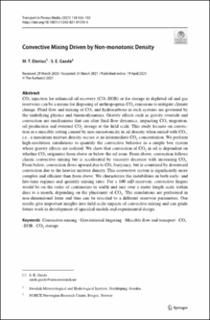| dc.contributor.author | Elenius, Maria | |
| dc.contributor.author | Gasda, Sarah Eileen | |
| dc.date.accessioned | 2021-11-12T14:52:43Z | |
| dc.date.available | 2021-11-12T14:52:43Z | |
| dc.date.created | 2021-08-09T09:06:51Z | |
| dc.date.issued | 2021 | |
| dc.identifier.issn | 0169-3913 | |
| dc.identifier.uri | https://hdl.handle.net/11250/2829414 | |
| dc.description.abstract | CO2 injection for enhanced oil recovery (CO2-EOR) or for storage in depleted oil and gas reservoirs can be a means for disposing of anthropogenic CO2 emissions to mitigate climate change. Fluid flow and mixing of CO2 and hydrocarbons in such systems are governed by the underlying physics and thermodynamics. Gravity effects such as gravity override and convection are mechanisms that can alter fluid flow dynamics, impacting CO2 migration, oil production and eventual CO2 storage at the field scale. This study focuses on convection in a miscible setting caused by non-monotonicity in oil density when mixed with CO2, i.e., a maximum mixture density occurs at an intermediate CO2 concentration. We perform high-resolution simulations to quantify the convective behavior in a simple box system where gravity effects are isolated. We show that convection of CO2 in oil is dependent on whether CO2 originates from above or below the oil zone. From above, convection follows classic convective mixing but is accelerated by viscosity decrease with increasing CO2. From below, convection flows upward due to CO2 buoyancy, but is countered by downward convection due to the heavier mixture density. This convective system is significantly more complex and efficient than from above. We characterize the instabilities in both early- and late-time regimes and quantify mixing rates. For a 100 mD reservoir, convective fingers would be on the order of centimeters in width and mix over a meter length scale within days to a month, depending on the placement of CO2. The simulations are performed in non-dimensional form and thus can be rescaled to a different reservoir parameters. Our results give important insights into field-scale impacts of convective mixing and can guide future work in development of upscaled models and experimental design. | en_US |
| dc.language.iso | eng | en_US |
| dc.rights | Navngivelse 4.0 Internasjonal | * |
| dc.rights.uri | http://creativecommons.org/licenses/by/4.0/deed.no | * |
| dc.title | Convective Mixing Driven by Non-monotonic Density | en_US |
| dc.type | Peer reviewed | en_US |
| dc.type | Journal article | en_US |
| dc.rights.holder | © The Authors, 2021 | |
| dc.description.version | publishedVersion | en_US |
| cristin.ispublished | true | |
| cristin.fulltext | original | |
| cristin.qualitycode | 2 | |
| dc.identifier.doi | 10.1007/s11242-021-01593-3 | |
| dc.identifier.cristin | 1924613 | |
| dc.source.journal | Transport in Porous Media | en_US |
| dc.relation.project | Norges forskningsråd: 255510 | en_US |

